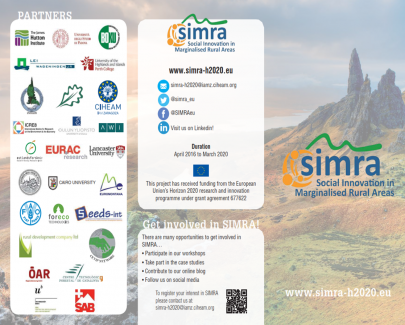Shaping Social Innovation in Marginalised Rural Areas (SIMRA)
Posted by Maria Nijnik on Wednesday 4 January 2017
As the Coordinator of the project "Social Innovation in Marginalised Rural Areas" (SIMRA), I would like to share the latest news from a stakeholder workshop in Bratislava, 26-28 October, and to bring you up to date on our progress since we launched SIMRA in April.
SIMRA is funded by the European Union's Horizon 2020 Research and Innovation Programme. Its ultimate purpose is to fill the significant knowledge gap in understanding and enhancing social innovation in marginalised rural areas; specifically in relation to agriculture, forestry and rural development.
In rural areas, common difficulties such as transport, infrastructure, housing and ageing populations, intersect with global issues, such as climate change, sustainability, and energy and food security. These challenges demand urgent solutions. Social innovation is expected to respond to social demands that are traditionally not addressed by markets or existing institutions, so improving the quality of life of people living in marginalised rural areas. Innovation reflects the capacity to create and implement new ideas which have the potential to deliver value. It entails new outcomes, i.e. products, services, models and social relationships, collaborations, as well as new fields of activity, e.g. social entrepreneurship and social enterprises (examples include community-owned renewable energy initiatives, helping disadvantaged groups gain access to work and healthcare), and institutional changes that should meet societal needs. These primary needs, that social innovation is expected to deliver, concern quality of life and well-being of people. Innovations begin with ideas, develop into prototypes and pilots, can become more stable initiatives, then potentially up-scale and may eventually create systemic changes.
At our event in Bratislava, members of the SIMRA consortium (consisting of 26 partners from 15 countries) met with more than 20 members of our Social Innovation Think Tank (SITT), within and beyond Europe, together with experts in forestry, agriculture and rural development.
The main objective of this workshop was knowledge exchange and mutual learning, about how to understand, assess and enhance social innovations to benefit marginalised rural areas. The meeting was endorsed by the Slovak presidency of the Council of the European Union,and it was hosted by the ‘SPECTRA Centre of Excellence’ – a joint research centre by the Institute of Forest Ecology, Slovak Academy of Sciences, Slovak University of Technology and Comenius University in Bratislava. The questions on the agenda included: What are the overall and specific variables of the emergence of social innovation in marginalised rural areas? How do they affect a range of success factors and the lessons learned in different rural areas? What are the most appropriate approaches, methods and tools that can be used for assessing social innovations? What does policy support to social innovation mean in different regional settings and contexts?
A series of working group sessions with our SITT enabled us to co-construct new knowledge by bringing together input from scientists and stakeholders. We were able to blend diverse theoretical positions into a coherent explanation of spatial variability of social innovation, encompassing its empirical diversity. We also developed improved knowledge of determinants of success, in order to answer the question of how to enhance the governance of social innovations, addressing specificities and priorities of social needs and new social relationships and collaborations.
I am very grateful to the SITT members for their splendid contribution to this workshop. I have a strong belief that after 4 years SIMRA will succeed in producing high quality scientific outputs and will eventually contribute to making a real difference on the ground, in marginalised rural areas of Europe and beyond, and especially in the Mediterranean region. To keep in touch with our activities do check our project webpage www.simra-h2020.eu, subscribe to the newsletter and follow SIMRA on social media (Twitter, Facebook, Linkedin). Thanks for your interest!
SIMRA has received funding from the European Union’s Horizon 2020 Research and innovation programme under Grant Agreement No 677622”. Click on the logo to find out more this funding programme.









Comments
Post new comment